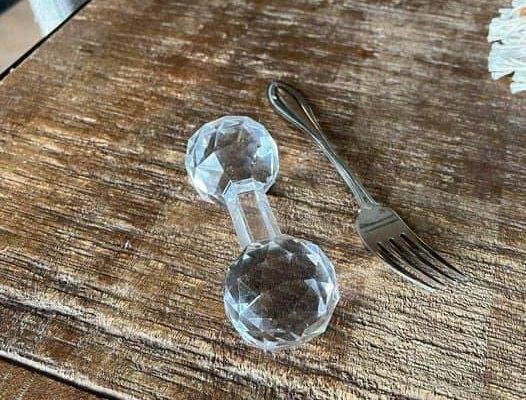While some vintage kitchen items are updated with more efficient or popular designs, others have become obsolete and are no longer used. Meanwhile, many confuse people of today, just this glass dumbbell or knife rest.
Searching for Glass Dumbbell Information

A woman found a glass dumbbell in a drawer at her in-law’s house and didn’t recognize the mysterious and pretty piece. As such, she turned to the internet for answers. According to another woman who offered some background, the object is a knife rest, and her grandmother would set the table with them for formal dinner parties.
Glass Dumbbells Can be Hundreds of Years Old

Incredibly, the glass dumbbell is over 100 years old. It hit the market in the late 17th century and remained a popular kitchen accessory until the mid-19th century. Now, it’s an adorable piece of glass resembling “a baby dumbbell” that adds a touch of old-time charm to any kitchen.
us Designs

The knife rest came in various colors and designs, all etched into glass pieces to make a set of decorative knife rests. One reason for such decorative pieces is that throwing parties and entertaining guests has been a prominent part of society but was particularly popular in the U.S. in the 1800s and 1900s. Therefore, kitchenware was more desirable in decorative sets, to add layers of ambience for party guests.
The Electric Knife

Unsurprisingly, the glass dumbbell is only one of many old kitchen items that hardly anyone today recognizes. For instance, an electric knife became popular in the mid-1960s, and within 10 years 1 in 3 American households owned the revolutionary kitchen item, intended to make chopping, slicing, and dicing easier and more time efficient.
Downsides of the Electric Knife

However, the electric knife had several drawbacks. While it didn’t require a knife rest, the electric knife was loud, unsanitary, and would often shred meat, rather than cut it. As such, it’s rarely found in homes today, except for specific things like holiday turkeys.
The Foley Fork

Meanwhile, the Foley Fork was versatile, serving the ability to mash, beat, mix, stir, and whisk almost any food one can think of. Rather it resembles a small outdoor rake. The Foley Fork was highlighted by Julia Child and soared in popularity. Although finding one of these in today’s kitchens is uncommon, it’s one of the few vintage items that can still be useful, despite it being outdated and out of production. In contrast, manufacturers have updated and still produce certain kitchen gadgets. A modern-day version of the Foley Fork exists and lives up to the versatility of its vintage version.
The Cake Breaker

With a similar design to the Foley Fork, the cake breaker is an intimidating-looking object that is baffling when found in kitchens today. However, it’s useful, particularly to those who throw parties with extravagant cakes and pies. Alternately, people often use a large chef’s knife or today’s version, which is more triangular and often smaller, so it fits in the drawer more easily.
Iron Trivets

Additionally, iron trivets are barely recognizable today but resemble tiny cast-iron pans. They were made with intricate designs and patterns and rested on legs so one could cook over a hot stove or set down a hot pan to avoid a burning hazard.
Fry Cutter

Another interesting item is the fry cutter. Although it’s much larger and less decorative than the glass dumbbells and vintage decorative kitchenware, the fry cutter has been around for generations. However, it changed its appearance several times before becoming modern design.
The Food Mill

Lastly, a food mill is a vintage kitchen item that resembles a pot. However, the lid had a crank. Apparently, it was designed to mash foods like applesauce, soups, or potatoes, theoretically taking the grunt work out of creating perfectly liquified or puréed foods. Meanwhile, this unfamiliar kitchen tool served a purpose that can be found in today’s kitchen, such as a food processor.
Knife rests and other vintage kitchen tools are unfamiliar today and few know what to do with them. However, there’s still a percentage of people who remember growing up watching their great-grandparents or grandparents cooking and using some of these bizarre yet fascinating if not adorable, long-forgotten kitchen tools and accessories.


